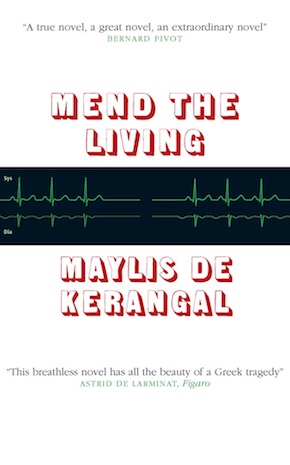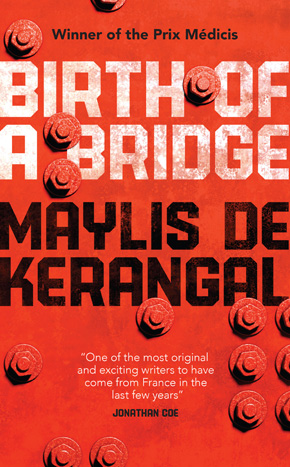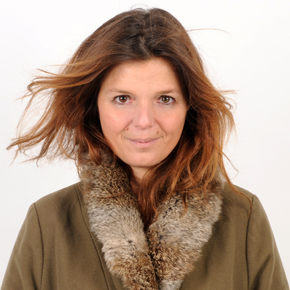From the heart
by Mika Provata-Carlone
“A searing, unforgettable read.” Irish Times
The title of Maylis de Kerangal’s second novel in English comes from Platonov, an unfinished and seldom performed play by Chekhov. One of his earliest works, ‘Little Plato’ is a distillation of every human gesture and movement, the ideas and existential questions that were to define Chekhov’s later work in its entirety. Above all, the play gives voice to the muted despair born of terrible traumas, irreversible catastrophes, our human tininess at the heart of infinity. Also to the arrogance concealed behind our feelings of helplessness, insignificance or sense of fatality:
Anna: Putting yourself down is the worst arrogance. Live. Move. Life is here.
Platonov: The world is so dark and strange. I will go. Walk… Destroy, trample, damage… I’m so ashamed. There’s no plot, it’s a hideous mess.
Towards the end of the play, one of the characters asks “what shall we do?” what life after tragedy? To which Nikolai Platonov replies: Bury the dead and mend the living. It is a call for perseverance as well as hope, for spiritual fortitude and the acknowledgment of both possibility and limitation.
Maylis de Kerangal’s novel is such an investigation of extremes, of vital centres and connections, of what is most private and intimate and of that which finds itself most alienated, severed. Or rather it is an abundant offering: it offers a story that questions the sense of an ending, the plot Platonov could not find. Hers is a literature that sees itself as a way to intelligibility, Kerangal’s own definition of the aims and purpose of writing. “To write is to establish a landscape,” she says, a physical and metaphysical landscape, a landscape of experience, of a presence through the senses and through writing. Landscapes are linked to memory, they have an eschatological function, reality, dimension. And so does writing, at its most fundamental level of form and language.
Mend the Living is the story of the unthinkable tragedy that can lurk behind the mundane or the sublime of everyday life. It is a delicate interplay of pathos with banality, of the exalted with the ordinary – a combination which is the formula for all true tragedy, the ancient tragic roots even of our modernity. Kerangal writes cosmogonic narratives heralding ends, limbos and new beginnings. Here three young boys whose real names have been replaced by nicknames, aliases that transform them into “planetary surfers” as opposed to mere French lycéens, wake up at the beginning of time, the “beginning of the day when the shapeless takes shape”. They will face creation in the form of perfect waves, cresting to the pinnacle of transcendence. They are infused with “terrible joy”, they are “archaic and perfect”, paragons of a “nomadic humanity”. They relish rolling American-English on their tongue, “as though they were heroes, foreigners”. “English that makes enormous words breezy, ‘vie’ and ‘amour’ becoming the offhanded ‘life’ and ‘love’”.After the “state of grace” attained by mastering perfect wildness, absolute nature, comes the accident: its cause perhaps a stray animal (a “psychedelic mermaid” off the décor of “The Van”) or just sheer exhaustion, human error. Two of the boys are saved. One becomes the eerie hero of Kerangal’s novel.
This is a narrative that is iambic in rhythm, elegiac in tone, unflinching in its gaze on all that transpires between life and death, the dead and the living. Kerangal never focuses on the single individual but rather uses the singular life as a focus point, as a conductor of a choir of voices. She has said that literature is the history of listening, and that the writer’s aim is to “guide the reader to listen to the voices, follow the immigrants” – be they characters, ideas, states of mind or of the soul. Her intertwined storylines are always contrapuntal, often seemingly discordant, but always progressing in relentless parallels. She gives us the tidal waves of a humanity in turmoil, lost at sea, shipwrecked (she is after all the daughter of a seaman), fragile and raw, for all the bravado and occasional undeniable cruelty, the often inescapable violence of the act of living.
Every word is a probe, every image an X-ray, every situation a full pathological analysis of the human psyche, of our social fibre and organism.”
As Simon Limbeau lies comatose after the accident the human individual during the next few hours will become human opportunity and promise for many except for himself; he will force us to question and invite us to hope. The moral dilemma of organ donation – violation? donation? sacrifice? miracle? – is the first terse episode of Kerangal’s galloping progression through the mental, physical, social and intimately personal stages of shock, desolation, the limbo of the living as they come to terms with a life that is here and yet gone. The announcement of death has “cleaved the continuity of time” as much as it has initiated a continuum of actions and reactions that will culminate at the multiple harvesting of organs from Simon Limbeau’s body.
There is a terrific tension, a superb equilibrium between the logos of science, the jargon of medical procedures and the language of pain, of mute incomprehensibility, of primordial empathy. Every word is a probe, every image an X-ray, every situation a full pathological analysis of the human psyche, of our social fibre and organism. Doctors declare that they are “feeling [their] way on the threshold of the living”, and concede that organ donation is a practice “that standardises tragedy for better efficiency”. Thomas Remige, the organ donation specialist, has been singing naked in his flat when he is told the news that Simon Limbeau has been pronounced brain dead and it is time, precious time, to harvest his organs. This is Kerangal’s way of telling us that before tragedy, before pain, we are all essentially naked, and often cold, in our humanity.
This is a perfectly accurate, exhaustive and unmitigated account of the process of organ harvesting and donation. It tackles the human element, the parents in this case, the body of the donor and the state of his consciousness or unconsciousness. We see, feel, experience, suffer and endure. At the centre of this whirlwind of urgency and drama, is the inanimate voice speaking, Simon’s heart summoning every flicker of light and life. And the last flicker is the first kiss. Memory is not an abstract construct, but very much “held in the body as a whole” – what will Simon’s heart remember when it beats in someone else’s body?
 Kerangal is not for the faint-hearted. She demands, unyieldingly, that our own heart engages, responds, fuses with the characters and the life of the story. One cannot read her to pass the time, one reads her to assess time, give it back its pulse, weight, worth. And time is never linear, even if what we claim to be science (this absolute knowledge of our own mechanical functions) ineluctably leads us to think so. Neither is it cyclical, Vico-like. Time moves straight ahead and flexes in every direction following human perception and emotion, creating nooks and crannies where we may secretly allow for empathy, for sorrow – and for impossible hope. As the father says goodbye to Simon (an act that seems delusional to Remige), he whispers “mana words that have crossed unaltered all the layers of language.” No linearity and no cyclicity could provide the space for the unspeakable, the unspoken, the mana word.
Kerangal is not for the faint-hearted. She demands, unyieldingly, that our own heart engages, responds, fuses with the characters and the life of the story. One cannot read her to pass the time, one reads her to assess time, give it back its pulse, weight, worth. And time is never linear, even if what we claim to be science (this absolute knowledge of our own mechanical functions) ineluctably leads us to think so. Neither is it cyclical, Vico-like. Time moves straight ahead and flexes in every direction following human perception and emotion, creating nooks and crannies where we may secretly allow for empathy, for sorrow – and for impossible hope. As the father says goodbye to Simon (an act that seems delusional to Remige), he whispers “mana words that have crossed unaltered all the layers of language.” No linearity and no cyclicity could provide the space for the unspeakable, the unspoken, the mana word.
Kerangal’s project is, in many respects, dystopian, her subject our own normalisation of the dysfunctional that has defined Western society since the 1960s. At the same time as a writer she says that she “suspends moral judgement in order to direct us towards empathy” – this is, for her, the true authorial gesture. In Mend the Living she rewrites constantly H.G. Wells’ Brave New World boring deeper, peering closer, using the sharpest contrasts such as humanity versus philanthropic purposefulness, mystery and the sacredness of life versus scientific know-how and life’s practical mechanics. Crucially, she asks us to consider mortality and immortality, faith and material reality. She is an unashamedly philosophic, anthropological writer, and it is perhaps this that endows her books with such genuinely powerful allure and her writing with such pure and perfect craftsmanship. For an author, she says, there is a single preoccupation, all else is a manifestation: how “can they elaborate a fiction that can question the world, how can they invite a relationship for literature with things beyond it, like philosophy?” For someone like Kerangal, literature is “a pause, a moment of reflection and of summoning the strength to lead us back to humanity… We write to know the world, to create a way towards questioning, towards freedom.”
Her novels are permeated by the sense of a mystery, of a mute and intangible eschatology. Her characters are both vagabonds and travellers.”
Life is a labyrinth, “where there is no entrance, no exit, no centre, but an infinity of paths, connections, branchings, vanishing points, and perspectives. [It] is a map of the brain… full of memory, coincidences, questions, it’s a space of chance and encounters.” The reason behind life, behind the maps of the brain, is the heart, “the centre of the mystery”, and the historical motive of all writing. It is a “porous gaze” upon the world, a gauze through which to filter experience, engage with the passions, be transfused in turn by the hearts of others and their gazes. It is, Kerangal insists, “an anxious relationship with the world”, and this porosity reflects the constant interaction between interiority and exteriority. In this context, the gesture of the transplant is a gesture of donation, a very rich, very strong act of commitment between the I and the world. “By de-privatising something private in order to put it back into the community” a new relationship is defined between life and death, even or especially through the violent contrast that is organ donation in its essence. It also underlines another principle of Kerangal’s writing and life: the I never stands in her books as the sole prism of analysis, of perception, of interpretation. The balance between the I and the world is what renders life, freedom possible and meaningful.
Her novels are permeated by the sense of a mystery, of a mute and intangible eschatology. Her characters are both vagabonds and travellers. In her writing margins assume a position of centrality, or, rather, the centre becomes marginalised – through language, through a questioning of safe places and of uncertain limits of existence. In Mend the Living the book’s ‘intuition’ is the double dimension of the heart – a muscle requiring a new literary language fusing fiction and science following the Enlightenment project and the humanism of Diderot, blending mystery, eschatology, empathy: what is man on earth?
For Kerangal, this duality reflects a male perspective, and it is women as characters and as a symbolic topos who can lead to a new encounter with freedom, with language, with literary and existential spaces. “The women are there to create new spaces against or in addition to male spaces,” Kerangal notes. For them, above all, freedom is not a birth but a conquest, they look into its cavities and plenitudes, think of it as an affirmation. Women for her achieve freedom through maternity, tenderness, the embrace that offers safety but also liberation. They think of freedom beforehand, have made, in her novels, a certain journey. They can also sense more directly, more inherently, that other seventeenth-century contradiction of whether man is external master and observer or constituent part, with all the limitations that entails, of creation. Men and women are infinitely small, Kernagal reminds us in her novels, superbly great, at the same time. “The writer is the strong presence [that] must erase itself in order to be strong”, she maintains, adhering to the principle of porosity, inter-infusibility she holds so crucial. “To be a writer is to exist within the plane of immanence.”
Anyone who has experienced a heart transplant or heart operation first hand will know how insecure the relation with language becomes in the retelling. Kerangal succeeds in evoking the horror, the violence, the anguish, the numbing doubt, but also the beauty, the human fragility and the moment of pure innocence that combined may perhaps mend the living. She is a writer who consciously focuses on form. The subject is not enough in itself, it is how a particular subject is elaborated and has evolved, it is the mystery of words and the tension between the potential and the impossible in language (the elusive and the malleable) that create the true literary work. Form comes first in her writing, and she possesses the rare gift of enchanting through words without mythifying, of creating pulsating realities and not simply documenting thrilling situations. Kerangal is Aristotelian: she guides souls and does not merely entertain minds; her aim is to write novels, fiction, that lead us back to reality. Even at its starkest, most gripping and poignant, Kerangal’s writing is full of balanced momentum and beauty, there is something Homeric and tremendous as well as lyrical about it. Humanity in her stories is often flawed and disunited, ecce homo moments succeed one another breathlessly, and for her characters the world is a challenge, a challenge of destruction, yet also one against devastation. Above all, her novels question the fatality of a sense of an ending: at the end of Mend the Living Claire, the recipient of Simon’s heart, is, we are told a translator – she performs word-transplants. She is the one who will survive the maelstrom, perhaps because she possesses the lost art of simplicity and the rare gift of human – all too human – attachment. There are too many details, too many signifiers cluttering existence, Kerangal seems to say in her torrential yet perfectly balanced stream of words, flux of lives, continuum of hearts and souls. We close the book wondering how Claire will repay the gesture (the donation of a life), gazing straight ahead, just as we return full circle to the novel’s beginning: “It is five-forty-nine” – a minute before the time Simon wakes up on his final day.
Mika Provata-Carlone is an independent scholar, translator, editor and illustrator, and a contributing editor to Bookanista. She has a doctorate from Princeton University and lives and works in London.
 Maylis de Kerangal grew up in Le Havre and lives in Paris. She is the author of five novels including Naissance d’un pont (Birth of a Bridge), winner of the 2010 Prix Franz Hessel and Prix Médicis, published by MacLehose Press in 2015. Réparer les vivants (Mend the Living), won the 2014 Grand Prix RTL-Lire and the Student Choice Novel of the Year from France Culture and Télérama. Mend the Living, translated by Jessica Moore, is out now from MacLehose Press. Read more.
Maylis de Kerangal grew up in Le Havre and lives in Paris. She is the author of five novels including Naissance d’un pont (Birth of a Bridge), winner of the 2010 Prix Franz Hessel and Prix Médicis, published by MacLehose Press in 2015. Réparer les vivants (Mend the Living), won the 2014 Grand Prix RTL-Lire and the Student Choice Novel of the Year from France Culture and Télérama. Mend the Living, translated by Jessica Moore, is out now from MacLehose Press. Read more.
Author portrait © Catherine Hélie
Jessica Moore is an author, singer-songwriter and translator based in Toronto. VP for Ontario in the Literary Translators’ Association of Canada, her previous translations include Turkana Boy by Jean-François Beauchemin, winner of a PEN America Translation Award, and Maylis de Kerangal’s Birth of a Bridge.

